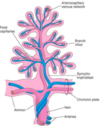S6) Placental Function and Dysfunction Flashcards
(35 cards)
In week 2 of embryological development, two distinct cellular layers emerge from the outer cell mass.
Identify them
- Synctiotrophoblast
- Cytotrophoblast

What happens to the inner cell mass during week 2 of embryological development?
Inner cell mass becomes the bilaminar disk:
- Epiblast
- Hypoblast

When does implantation begin and end?
- Commencement: day 6
- Completion: day 9

What are the 2 cavities in the embryo?
- Amniotic cavity
- Yolk sac

What has happened by the end of week 2 of embryological development?
- The conceptus has implanted
- The embryo and its two cavities are suspended by the connecting stalk within a supporting sac called the chorionic cavity

What is the fate of the embryonic spaces after the end of week 2?
- Yolk sac disappears
- Amniotic sac enlarges
- Chorionic sac is occupied by the expanding amniotic sac

What does implantation achieve?
- Establishes the basic unit of exchange
- Anchors the placenta
- Establishes maternal blood flow within the placenta

Identify and describe the 3 forms of villi created by implantation
- Primary villi: early finger-like projections of trophoblast
- Secondary villi: invasion of mesenchyme into core
- Tertiary villi: invasion of mesenchyme core by fetal vessels

What is meant by the statement ‘implantation is interstitial’
Implantation is interstitial as the the uterine epithelium is breached and the conceptus implants within the stroma
Briefly, how does the placenta change as the foetus develops?
The placental membrane becomes progressively thinner as the needs of the foetus increase
What are chorionic villi?
- Chorionic villi are villi that sprout from the chorion to provide maximum contact area with maternal blood
- They contain foetal blood vessels

What is the placenta?

The placenta is an organ, specialised from the chorionic membrane, that connects the developing foetus to the uterine wall to allow nutrient uptake, thermo-regulation, waste elimination, and gas exchange

Identify 2 things that can go wrong with implantation
- Implantation in the wrong place
- Incomplete invasion
Identify 2 clinical conditions which can result from incomplete invasion
- Placental insufficiency
- Pre-eclampsia
Identify 2 clinical conditions which result from implantation at an inappropriate site
- Ectopic pregnancy
- Placentae praevia
Describe implantation in ectopic pregnancy and the consequences of such
- Implantation at site other than uterine body (peritoneal/ ovarian)
- Very quickly becomes life-threatening emergency

Describe implantation during placenta praevia and the consequences of such
- Implantation in the lower uterine segment
- Can cause haemorrhage in pregnancy
- Requires C-section delivery

Describe how the invasion during implantation is controlled
- Transformation of the endometrium in the presence of a conceptus
- Conceptus becomes the decidua
- The decidual reaction provides the balancing force for the invasive force of the trophoblast

What is the decidual reaction?
- The decidual reaction is the set of changes in the endometrium of the uterus that prepare it for implantation of an embryo
- These changes include swelling of stromal cells due to accumulation of glycogen and other nutrients

What happens if the decidual reaction is sub-optimal?
Sub-optimal decidual reactions can lead to a range of adverse pregnancy outcomes
Describe the structure of the chorionic villus

Over the course of pregnancy, the ‘placental’ barrier becomes thinner.
Describe this in terms of the chorionic villi
- First trimester villus: thicker barrier (blue)
- Third trimester villus: barrier at optimal “thinness” (pink)

Identify the 2 classes of hormone produced by the placenta
- Protein
- Steroid
Identify 2 steroid hormones produced by the placenta
- Progesterone
- Oestrogen




